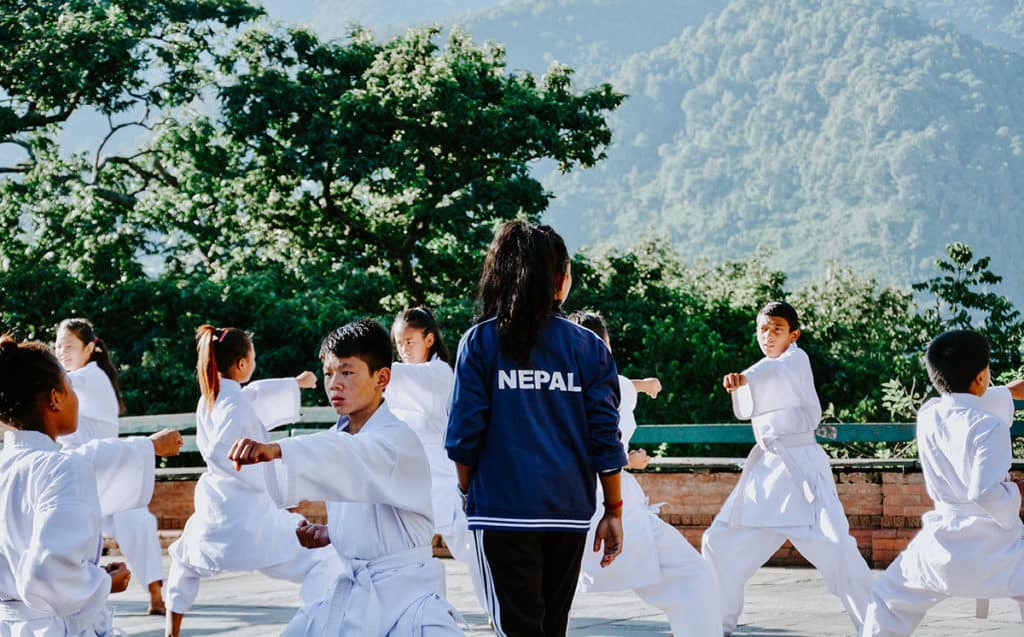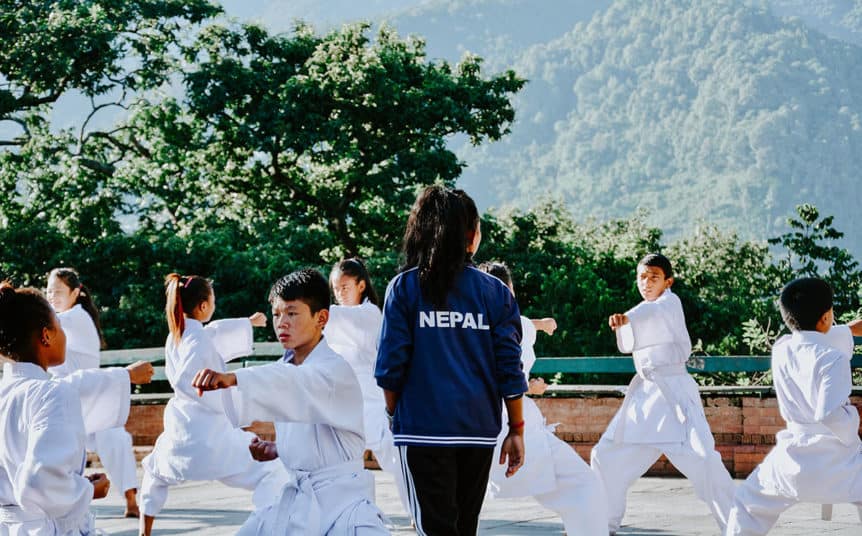
In the art of TaeKwondo, there are numerous stances taught to the students. Each stance has a purpose that either provides different attacks, defenses, and builds the physical strength of students.
What are TaeKwonDo Stances? Stances in Taekwondo are the foundations by which all offensive and defensive moves start. Having the proper stance is vital in performing correctly any kick, block, or punch in TaeKwonDo.
When I started TaeKwonDo I did not fully appreciate the importance of a good stance and so I was always off balance and did not have the power I should have had.
The Principles of a Proper Stance in TaeKwonDo
A proper stance in TaeKwondo includes the following:
Balance
In TaeKwondo much like every martial, the importance of balance is stressed when teaching a proper stance. Without balance in a stance, there will always be flaws within a students attacks and defenses.
Relax
Relaxing your body, while in a stance is very important. It allows you to move more fluidly and react quicker.
Straight Back
Your back will need to be straight and aligned, while in a stance. If your spine isn’t properly aligned in a stance, then your base is probably off.
Tight Core
Your abdomen needs to be tight to control the movements, while in a stance.
Foot Placement
You need to be on the balls of your feet when in a stance. It ensures weight is evenly distributed on both legs and makes reaction time is quicker.
Breath
Always remember to breathe. It makes keeping a proper stance easier.
The 10 Basic TaeKwonDo Stances
There are several dozen different TaeKwondo stances and each association has their own list of stance that must be learned. Below are the ten most common stances with definitions for each one and their purpose.
1. Attention Stance – Charyot Sogi
The attention stance is how a student stands at the beginning of class, before transitioning into another stance, and before being dismissed from class. Eyes facing forward, back straight, feet touching, and hands at your side. It’s called the attention stance, because the student is standing at attention waiting for the instructor to give directions
2. Ready Stance – Joon Bi Seogi
When the instructor shouts Joon Bi, the students shout either Kiai or Aiya and get into ready stance. Your left foot moves shoulder width apart, while your hands make fists and go below your belt with the elbows slightly bent. Back is straight with the knees are slightly bent and you’re on the balls of your feet ready to move.
3. Walking Stance – Ap Seogi or Gunnun Sogi
This stance is called the walking stance, because it looks the same as if you took a step forward. Your left foot takes a step forward and your feet are shoulder. The back foot is at an angle up to 30 degrees and weight is evenly distributed between both feet.
Generally, this stance is used for offensive moves due to the feet placement.
4. Back Stance – Dwi Kubi Seogi or Dwitgubi
In this stance, your feet are in an L shape with the front foot forward and back foot at 90 degrees. This stance is one of the few exceptions where weight isn’t evenly distributed to both feet. 70% on your back leg and 30% on the front with your chest sideways to the opponent.
This is a predominantly defensive stance to avoid strikes to the chest and move away.
5. Horse Riding/Horse Stance/Sitting Stance – Joom Choom Seogi
This stance is used in TaeKwondo to build leg strength in the students. You’re in an exaggerated squat stance about 4 steps across and shoulders, knees, and feet are facing forward. Fists are connected to the sides of your belt with the abdomen tight and back straight.
Horse stance is usually for exercise purposes, but it is an offensive stance, where punches and kicks can be thrown from
6. Cross Stance – Kkoa Seogi
This is one of two cross stances with the other being a rear cross stance also called Dwi Kkoa Seogi. This stance is generally used for forms such as in WTF form #5 or Taegeuk Oh Jang.
This stance occurs when your feet cross while making a turn to the front, back, or side. If the moving foot shifts to the front it’s a Kkoa Sogi and when it shifts to the back it’s a Dwi Kkoa.
7. Front Stance/Forward Stance – Ap Kubi Seogi or Apgubi
Begin this stance by taking a big step forward with your front foot. The length and width between your feet 1.5-2 shoulders. Your front leg is going to be in a lunge position with most of your weight on it and your foot facing forward. The back leg will be straight and the foot will be at a 45 degree angle to the side.
A front stance is an offensive, where you’re keeping a distance and have your back leg chambered to throw kicks.
8. Tiger/Cat Stance – Beom Seogi
Tiger/Cat stance is considered a lower version of the walking stance. Your feet are closed together with your knees bent. The heel of the front foot is off the ground and the back foot is flat holding most of the weight. This stance makes big and small motions forward or backward easy.
Defense is the main objective of this stance used for easy movement and the front foot can protect the groin.
9. Fighting Stance – Gyoroogi Seogi
This is the stance you take when you’re sparring. Your feet are shoulder width apart with both feet in line with one another and the front foot holding a little more weight. Chin is down and hands are up ready to defend yourself.
There are two different types of fighting stances. Open stance and closed stance. This will depend if you and opponent both fight on the same side or not. Both stances have different dynamics and approaches.
10. Crane Stance – Hakdari Seogi
If you’ve seen the movie Karate Kid this is basically the same stance. The front foot is off the ground with the knee bent and the back foot is angled to the side. It is similar to how a crane stands with the front foot almost touching the back knee for balance.
From this position jumping kicks are available.
The Different Stances of the TaeKwondo Associations WTF ITF and ATA

The top three organizations in TaeKwondo are the WTF, ATA, and ITF. Each have their own list of stances they recognize with different Korean names that are taught at the official academies.
Here are two lists for the WTF and ITF. (The ATA teaches stances from each of these lists.)
World TaeKwondo Federation:
- Assisting Stance (Gyeotdari Seogi)
- Back Stance (Dwi Kubi Seogi)
- Closed Stance (Moa Seogi)
- Crane Stance (Hakdari Seogi)
- Cross Stance (Kkoa Seogi)
- Diagonal Stance (Mo Seogi)
- Fighting Stance (Gyoroogi Seogi)
- Front Stance (Ap Kubi Seogi)
- Horse Stance (Jo Choom Seogi)
- Parallel Stance (Narani Seogi)
- Ready Stance (Joon Bi Seogi)
- Side Stance (Yeop Seogi)
- Tiger or Cat Stance
- Walking Stance (Ap Seogi)
International TaeKwondo Federation:
- Attention Stance (Charyot Sogi)
- Bending Stance (Guburo Sogi)
- Closed Stance (Moa Sogi)
- Crouched Stance (Oguryo Sogi

